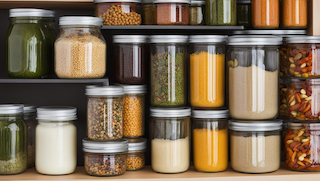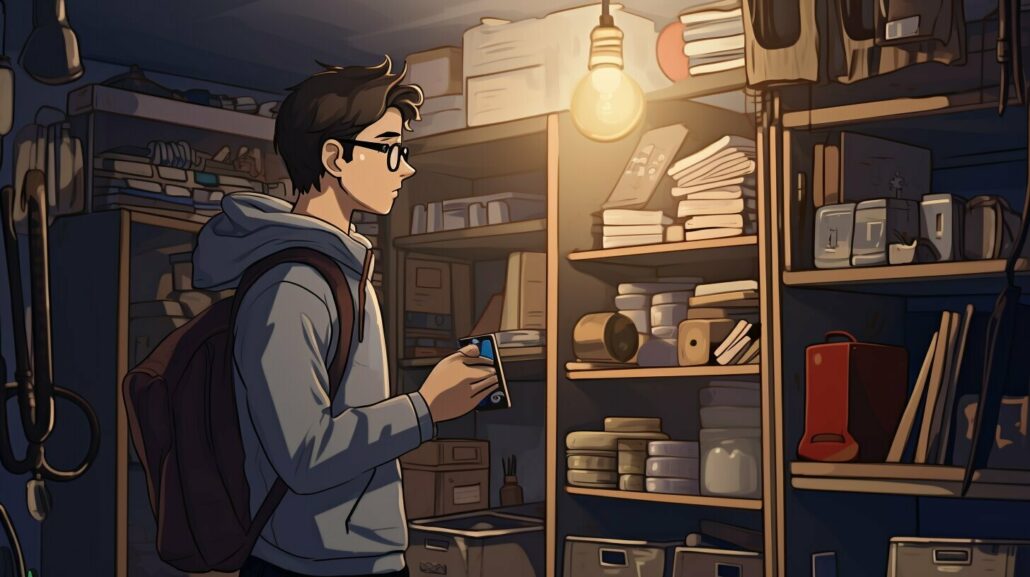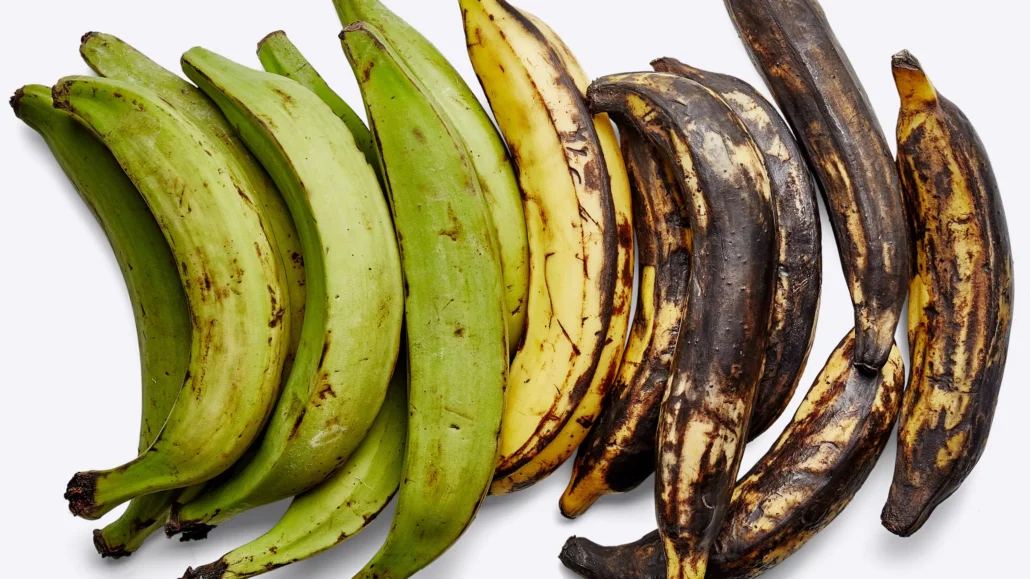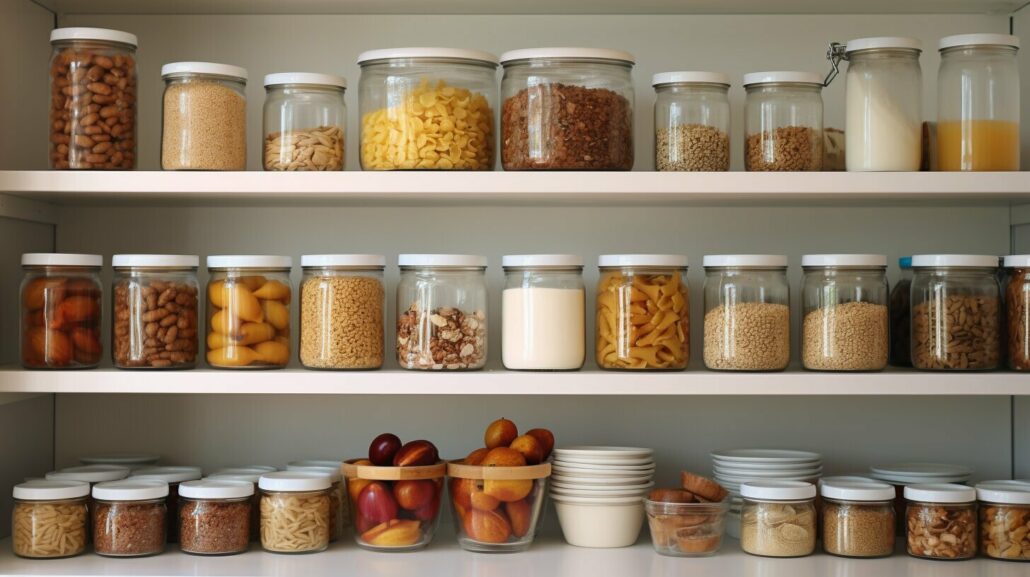As a conscientious consumer, I am always on the lookout for functional, attractive, and environmentally friendly food storage options. After weighing the pros and cons, I put together this comprehensive guide to help others make the best choices for their lifestyle when considering whether to store food in plastic or glass jars. In this article, you will learn about various factors that influence the decision, including environmental impact, health and safety, and practicality.
Key Takeaways
- Determining the optimal food storage solution involves a thoughtful analysis of various factors, including environmental concerns, health impacts, weight, and functional aspects
- Glass jars offer superior recyclability, durability, and safety for preserving food freshness and preventing contamination from harmful chemicals
- Plastic jars provide advantages in terms of lightweight, transport-friendly properties, and low cost
- High-quality, BPA-free plastic containers are the preferred choice for portable use, such as work lunches or children’s meals
- Maintaining your food storage containers is essential for both their longevity and your health
Understanding the Dilemma: Choosing Between Plastic and Glass
Deciding whether to store food in a plastic jar for food storage or a glass jar for food storage is a complex task influenced by a variety of factors, including personal preferences, environmental and health considerations, space constraints, weight, and overall functionality for specific needs such as preserving food freshness or transporting meals.
When comparing plastic and glass as optimal food storage containers, both options present unique advantages and challenges. The choice ultimately depends on balancing priorities and considering what is most important for your household. Let’s dive into the key factors to consider when making this decision:
Environmental impact, health considerations, space constraints, weight, and overall functionality for specific needs are all important aspects to think about when choosing between plastic and glass for food storage.
- Environmental considerations: Does the carbon footprint of the production and disposal of the container matter to you?
- Health and safety concerns: Are you worried about the potential for chemical leaching from plastics?
- Space constraints: How much storage space do you have available in your kitchen? Do you prefer stackable containers?
- Weight: Is the weight of the container a concern, especially if you need to carry it for transportation?
- Functionality: Do you require airtight containers to preserve the freshness of your food or specific features such as compartments for portioning meals?
Understanding your priorities will help you navigate the dilemma and make the best choice for your specific needs. In the next sections, we will explore the advantages and disadvantages of both options in greater detail, allowing you to make a well-informed decision.
For the Sake of the Environment: Why Glass Jars May Be Superior
In recent years, increasing emphasis has been placed on the importance of recycling and sustainability. When it comes to storing food, whether in a pantry or for transportation, choosing the right container material can have a significant impact on the environment. In this section, we will discuss the environmental benefits of glass jars and the downsides of plastic waste.
Recyclability and Lifespan
One of the major advantages of glass jars is their impressive lifespan and recyclability. Glass is 100% recyclable and can be recycled endlessly, with no loss of purity or quality throughout the recycling process. This means that a single glass jar can be used and recycled several times, reducing the overall waste generated and keeping our environment cleaner.
“Glass is 100% recyclable and can be recycled endlessly, with no loss of purity or quality.”
On the other hand, plastic containers have a shorter lifespan and limited recyclability in comparison to glass. Not all types of plastics are accepted in municipal recycling programs, and even those that are accepted, can only be recycled a certain number of times before losing their strength and quality.
The Downside of Plastic Waste
The accumulation of plastic waste in the environment is a growing concern as it takes an incredibly long time for plastic to break down and decompose. When plastic is not recycled or repurposed, it ends up in our landfills, oceans, and the natural environment, causing significant harm to wildlife, ecosystems, and human health.
Some companies, such as Preserve, have attempted to combat this issue by using recycled plastic in their products. However, the availability of recycled plastic and local recycling capabilities are often limited, meaning that a large portion of plastic waste still goes unrecycled and continues to contribute to environmental degradation.
- Plastic takes a long time to decompose in the environment.
- Not all plastic types are accepted in municipal recycling programs.
- Only a limited amount of plastic is repurposed, with the majority ending up as waste.
In conclusion, the environmental benefits of glass jars and their superior recyclability make them an excellent choice for those looking to store food in an eco-friendly manner. Despite the convenience of plastic containers, their limited recycling capabilities and the environmental impact of plastic waste make them a less than ideal option for sustainable food storage.
Evaluating Health Impacts: The Safety of Glass Versus Plastic
As consumers, it is crucial we consider the health impacts of food storage when choosing between glass and plastic containers. Glass is often regarded as the safer choice for several reasons. Primarily, glass is non-porous, which means it will not absorb food particles or odors, as well as being easier to clean and sanitize thoroughly.
Moreover, glass containers can generally withstand high temperatures without the risk of releasing harmful chemicals. On the other hand, some plastic containers have been found to contain substances like bisphenol A (BPA) and phthalates, which are known as endocrine disruptors. However, in response to consumer concerns, many manufacturers have started to offer BPA-free alternatives, which provide safer options for food storage.
| Advantages | Disadvantages |
|---|---|
| Does not release harmful chemicals | Can release hazardous chemicals |
| Non-porous | May absorb smells and stains |
| Withstands high temperatures | Sensitive to high temperatures |
| Thoroughly sanitizable | May release toxins if not carefully cleaned |
In summary, while plastic containers have their benefits, especially regarding weight and portability, they may be more likely to expose consumers to potential health risks than their glass counterparts. Opting for safe food containers made of high-quality, BPA-free plastic is essential for ensuring a healthy food storage experience while maintaining the allure of lightweight and portable containers.
The Convenience Factor: When to Opt for Plastic Jars
In certain situations, the portability of food containers and the need for lightweight food storage take precedence. Whenever transportation plays a significant role, plastic containers offer a more convenient option compared to their glass counterparts. The lighter weight and increased durability make them an excellent choice for work lunches and children’s meals.
Lightweight and Transport-Friendly Storage
When it comes to transportation, the convenience of plastic jars cannot be overlooked. The lightweight design, coupled with their resilience against breakage, is a major plus for anyone looking to transport food without any hassle. In addition, plastic containers can be equipped with specialized lids for small components, making them even more practical and versatile. If they happen to break or become damaged, they are also easily replaceable without breaking the bank.
Plastic containers are the go-to option for those who require lightweight, easily transportable food storage solutions.
Here are some of the key benefits of using plastic jars for transportation:
- Lightweight and easy to carry
- Durable and less likely to break
- Specialized lids for small components
- Economically replaceable
- Stackable, saving space
| Characteristic | Plastic Containers | Glass Containers |
|---|---|---|
| Weight | Lightweight | Heavier |
| Transportability | High | Lower |
| Durability | Resilient against breakage | Fragile, prone to breakage |
| Replacement Cost | Affordable | More expensive |
| Space-saving | Stackable | Less stackable |
In conclusion, when considering the convenience and portability factors, opting for plastic jars makes sense. Although glass jars are preferable for long-term storage and other aspects, plastic containers excel in terms of lightweight and durable food storage solutions, particularly for on-the-go meals and children’s lunches.
Gauging Durability: How Plastic and Glass Hold Up Over Time
When it comes to the durability of food containers, it’s important to understand how both plastic and glass materials hold up over time. Considering factors such as wear and tear, absorption of food odors and stains, and the longevity of these containers can help you make the best decision for your specific storage needs.
Plastic containers often become victims of wear and tear, resulting in undesirable cracks or leakage. Additionally, these containers have a tendency to absorb food odors and stains over time, especially when improperly cleaned or exposed to high temperatures. This not only limits their lifespan but can also impact the freshness and quality of the food stored inside.
“Plastic containers may degrade over time, especially when improperly cleaned or subjected to high heat.”
On the other hand, glass containers are known for their long-lasting durability. When cared for properly, they can maintain their clarity and resist stains and odors for years.
| Plastic Containers | Glass Containers |
|---|---|
| Prone to wear and tear | Highly resistant to wear |
| Can absorb food odors and stains | Resists stains and odors |
| May degrade over time due to high heat | Withstands high temperatures without degrading |
| Shorter lifespan overall | Can last years if cared for properly |
When considering which food storage containers will best preserve food in jars and maintain their quality, it’s important to weigh the pros and cons of both options. While plastic containers may be less expensive upfront and easier to transport, their lack of durability and potential for odor and stain absorption may make glass containers a more effective long-term option.
Choosing Containers for Kids’ Lunches: Safety and Practicality
When it comes to packing lunches for our children, safety and practicality are top priorities. Plastic containers emerge as the ideal choice for kid’s lunches, offering lightweight characteristics and specialized compartments that are suitable for young ones on-the-go.
The Portability and Durability of Plastic
One of the most significant benefits of plastic food storage for children is that they are easy to transport, given their lightweight nature. This makes it convenient for kids to carry their lunchboxes without the added heft of glass containers. Furthermore, plastic containers are less likely to break when dropped, reducing the risk of injury and spills during lunchtime.
Many safe containers for kids come with multiple compartments, which can be conveniently customized according to the specific lunch menu of the day. This allows for a neat and organized meal, with each food item separated and easily accessible.
For example, a lunch container from Bentgo Kids features five compartments that are portioned to provide healthy, balanced meals for children.
The durability of practical lunch containers is also an important factor, as children’s lunchboxes are often subjected to rough handling. High-quality plastic containers offer both robustness and longevity, ensuring a safe and efficient lunchtime experience.
- Choose BPA-free and phthalate-free plastic containers.
- Opt for containers with tight-sealing lids to prevent leaks.
- Select a design that is easy to open and close for small hands.
- Consider dishwasher-safe containers for easy cleaning.
In summary, when selecting food storage containers for children’s lunches, prioritize both safety and practicality. Plastic containers offer a lightweight and portable solution, ensuring a pleasant and enjoyable meal experience for kids on-the-go. With the right choice of high-quality, BPA-free, and durable containers, parents can effectively pack their children’s lunches while alleviating environmental and health concerns.
Cost Comparison: Balancing Budget with Quality
When looking for affordable food storage solutions, the cost plays a significant role in determining whether to choose plastic or glass containers. To find the most cost-effective food jars, one needs to consider not only the initial investment but also the potential long-term savings and benefits of each option.
Plastic containers are often favored for their low cost and wide availability. Their lightweight and stackable designs make them an attractive choice when space-saving is a priority. However, selecting the cheapest option may not always provide the best value in the long run.
Quality matters when choosing food storage containers as it directly impacts the lifespan and effectiveness of the jars.
In contrast, glass containers typically have a higher upfront cost compared to plastic alternatives. Despite the initial investment, glass jars offer a longer-lasting, safer, and more sustainable solution, thus potentially saving money over time as you won’t need to replace them as frequently.
| Characteristics | Plastic | Glass |
|---|---|---|
| Initial cost | Low | High |
| Longevity | Varies, potential wear and tear | High, more durable |
| Health risks | Potential for harmful chemicals in certain plastics | Low, no harmful chemicals |
| Environmental impact | High | Low |
Overall, the choice between glass and plastic jars largely depends on individual preferences, budget considerations, and specific uses. It is essential to weigh the glass vs plastic cost and benefits when selecting the best food storage containers for your needs.
- Evaluate your priorities: Is long-term sustainability more important to you than a lower initial investment?
- Consider how you’ll be using the containers: Are they mainly for home use, or will they be frequently transported?
- Compare the practicality or specific features of each option: Do you need dishwasher-safe jars? Is airtight storage essential?
By carefully considering these aspects, you can make an informed decision that balances budget considerations with quality and functionality for your food storage containers.
Storing Leftovers: Glass Jars for Preserving Food Freshness
When it comes to storing food in jars for freshness, glass containers are an excellent choice. With their non-porous qualities, glass jars can preserve the flavor and freshness of various types of food, especially wet ingredients, without absorbing odors or stains.
The ability to create an airtight jar for food storage makes the glass jars even more ideal for keeping your leftovers fresh. This is due to the tight seal that is formed when the lid is closed, effectively preventing air and contaminants from entering the jar.
Non-Porous Qualities of Glass
One of the advantages of using glass containers for preserving food in jars is their non-porous nature. This means they do not absorb smells, flavors, or stains from the food stored within, which helps maintain the food’s original taste and freshness. Besides, glass containers can be thoroughly cleaned in a dishwasher, further ensuring that they maintain a like-new appearance over time.
Glass jars provide an ideal environment for preserving food freshness, as their non-porous surfaces prevent the absorption of odors and stains from stored items.
Below is a table listing some additional benefits of using glass containers as a food storage solution:
| Benefit | Description |
|---|---|
| Long-lasting freshness | Due to their airtight seal, glass jars maintain the freshness of both dry and wet ingredients for extended periods. |
| Transparency | Glass containers allow you to easily identify the contents inside, making it easier to find and manage stored food items. |
| Environmentally friendly | As a sustainable option, glass jars can be recycled and repurposed multiple times without diminishing in quality. |
| Chemical-free | Glass containers are free from harmful chemicals, such as BPA and phthalates, which can leach into food when using some plastic jars. |
In conclusion, for those seeking an effective method of preserving food freshness without compromising on quality or sustainability, glass jars are an excellent investment. Their non-porous nature, airtight seal, transparency, and durability make them an ideal choice for storing leftovers and maintaining the original taste and flavor of your food.
Caring for Your Food Storage Containers
Proper maintenance of food storage containers is crucial for their longevity. While glass containers can generally withstand high temperatures and are dishwasher-safe, some plastic containers may require hand-washing or careful cleaning to prevent warping and to minimize wear and the release of chemicals.
To ensure that your clean food storage containers remain safe and in optimal shape, consider the following care tips:
- Hand-wash plastic containers: Despite many being labeled as dishwasher-safe, it’s still a good idea to hand-wash plastic containers to prevent them from warping or getting damaged in high heat.
- Thoroughly clean glass containers: Glass food jars and containers can be safely put in the dishwasher or hand-washed in hot, soapy water to maintain their hygienic condition.
- Store with care: Organize your food jars properly to avoid clashing that could lead to breakage or scratches, especially for glass containers.
- Inspect regularly: Check your food containers for signs of wear or damage and replace them when necessary to maintain the longevity of food containers and ensure safe food storage.
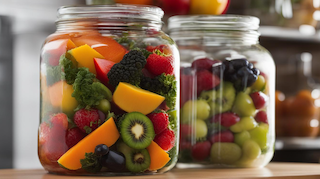
Remember, keeping your food storage containers in excellent condition not only extends their lifespan but also helps guarantee that your food remains fresh and safe to consume.
Whether you choose glass or plastic to store your food, maintaining your containers is key. By taking these simple steps to clean food storage containers and maintain food jars, you can enjoy a healthy, cost-effective, and environmentally-friendly food storage experience.
Now that you know how to care for your food storage containers, think about which material suits you and your needs best. Regardless of your choice, remember that looking after them well will help you maximize the benefits of both types of containers.
The Visual Appeal: Aesthetic Considerations of Food Storage
When it comes to creating a visually pleasing and organized kitchen space, the appearance of your food storage containers plays a significant role. Both glass and plastic containers offer advantages in terms of aesthetics, but there are some differences to consider.
Glass containers usually have a more attractive appearance, making them an excellent choice for aesthetic food storage. Due to their non-porous nature, they can maintain a like-new appearance over time with proper cleaning. The clear glass showcases the contents, contributing to a neat pantry and easily identifying the items you need. Additionally, glass jars can be combined with stylish labels and matching lids for an elegant and unified look.
On the other hand, plastic containers can become discolored and scratched over time, reducing their visual appeal. However, certain high-quality plastic containers boast transparency similar to that of glass, contributing to an organized and aesthetically pleasing pantry presentation. Many plastic containers also come in various colors, allowing for a personalized and vibrant touch in your kitchen.
Ultimately, choosing the right food containers for your pantry depends on your personal preferences regarding aesthetics, as well as practicality.
Keeping a Neat and Attractive Pantry
Whether you choose glass or plastic containers for your food storage, ensuring that your pantry remains neat and attractive can be accomplished with a few simple steps:
- Labeling: Label your containers with clear and legible writing, specifying the contents and expiration dates for easy identification.
- Organization: Arrange your containers in categories, such as grains, spices, or baking supplies, to create a streamlined and orderly layout.
- Maintenance: Regularly clean and check your storage containers to ensure they remain in good condition, replacing any damaged or worn-out items promptly.
- Consistency: Opt for a consistent style, whether it be glass or plastic, to create a visually cohesive space.
By giving thought to the aesthetic aspects of your food storage, you can create a neat pantry that not only looks appealing but also makes your kitchen experience more enjoyable and efficient.
My Personal Verdict on Storing Food: Plastic or Glass Jars?
When it comes to choosing between plastic and glass jars for food storage, a multitude of factors come into play. As a professional copywriting journalist, I have weighed the pros and cons associated with environmental impact, health and safety, durability, aesthetics, and functionality in order to make an informed choice for my personal food storage practices.
Overall, I find that glass containers emerge as the preferred choice for storing food at home, especially given their non-porous nature, impressive lifespan, and 100% recyclability. Although glass jars come with a higher initial cost and need to be handled more carefully due to their heavier weight, their benefits in terms of health and safety, environmental considerations, and durability far outweigh these drawbacks. Additionally, glass containers are often more aesthetically pleasing than their plastic counterparts and can retain a like-new appearance over time through proper care.
That being said, I still see a place for plastic containers in specific situations, particularly for storing large bulk items and for portability when it comes to work or kids’ lunches. In these cases, choosing high-quality, BPA-free plastic options is imperative to ensure food is stored safely and the containers hold up well over time.
In conclusion, while both plastic and glass food storage options have their merits, the key to choosing the best jar is to consider the specific context of use, personal preferences, and adherence to best food storage practices. By making well-informed decisions and maintaining a balance between environmental sustainability, health, and convenience, we can store food safely and responsibly.

